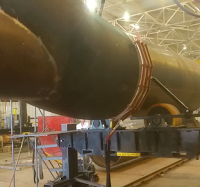 |
| Resistor controlled welding machines by AFTEK. |
Resistor control has been used in
multi-operating welding systems in shipyards and heavy construction for decades. In the heyday of nuclear power plant construction in the USA, nearly all were built using multiple-operator systems. From the thirties until about 1990, nearly all multiple-operator systems were the designed similarly. They used a large bulk power supply with “grids” connected by cables to form a system of distributed power. This system minimized the use of high voltage primary power, distributing 75-80 volts of secondary voltage instead.
As these systems grew in popularity, the concept of “packs” became popular. These packs provided 2, 4, 8, and 16 arcs in a steel rack, and all being connected to a separate power supply. A now defunct company named
Big Four developed the concept of connecting multiple-operator systems in a loop arrangement, which resulted in greatly improved voltage stability. In 1990, this loop concept was further refined into integrated, modular welding packages. These newly designed systems provided an internal power supply sufficiently sized to provide power to all the arcs without any interference.
Loop systems are still being used today. They are viewed as a very economical welding alternative. For example, for a loop that needs twenty MIG arcs, it is possible to use (4) 500-amp power supplies connected to a single 500 MCM cable which circles the work space. Twenty control modules can be connected wherever needed on the closed loop of cable. A huge cost savings is realized in having to establish just four (4) primary connections instead of twenty (20).
Most conventional arc welders use a transformer-like device called a reactor to control the "heat" of the welding arc. If you examine the Voltage/Amperage (V/A) curve for a conventional constant current (or constant voltage) welding power supply, you’ll see spikes. This is inherent in the design of conventional arc welders. The V/A curve of a resistor controlled arc welder, on the other hand, is a straight line.
Resistor controlled arc systems provide more consistency of power - if you shorten the arc, thus lowering the arc voltage, the current will increase, and maintain virtually the same power (heat). If you lengthen the arc, you raise the voltage, but the power remains virtually constant. Why is this important? In any welding process, increasing the amperage increases penetration and increasing the voltage widens and flattens the head (and reduces penetration). With a resistor controlled arc, if you are welding along the seam and it closes, shortening the arc length will increase penetration. If the weld opens, lengthening the arc will lessen the penetration and widen the weld. This provides excellent control right in the electrode holder.
AFTek, a US manufacturer located in Chattanooga, TN and division of
Hotfoil-EHS, is the sole remaining manufacturer of resistor controlled welding machines in the USA. Their resistance welders are an acknowledgement of the superior design Big Four developed years ago, while improving performance with edge-wound coils for better heat dissipation (thus better current control) and rotary switches for current selection, even under load.






